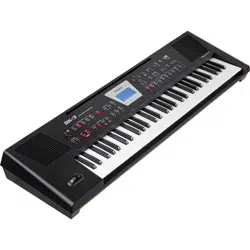Loading ...
Loading ...
Loading ...

Menu options
44
Volume
Adjusts the volume of the selected keyboard part.
Selecting “0” means that the part is question is no longer audible.
Parameter Setting
Volume 0~127
Reverb Send
Use this parameter to set the reverb send level (i.e. the amount of
eect that should be added).
Parameter Setting
Reverb Send 0~127
Chorus Send
Use this parameter to set the chorus send level (i.e. the amount of
eect that should be added).
Parameter Setting
Chorus Send 0~127
Panpot
Use this parameter to change the stereo placement of the selected
keyboard part. “L63” means “hard left” and “R63” represents “hard
right”. Choose “0” if the sound should be at the center of the stereo
image.
Parameter Setting
Panpot L63~0~R63
Key Touch (velocity sensitivity)
The BK-3’s keyboard is velocity sensitive, allowing you to control the
timbre and volume of the keyboard parts by varying the strength
with which you strike the keys.
1. If you want to edit this setting, you have to press the
[ENTER] button to select the “Key Touch” page.
2. Select and set the desired parameter(s). See “Moving
Between Windows and Setting Parameter Values” (p.
18).
The following parameters are available:
Parameter Setting Explanation
Curve
High, Medium,
Low, Fixed*
• “High”:
Select this setting for maximum expressive-
ness. Even small variations of the force with
which you strike a key produce audible
changes. The trade-o is, however, that you
have to strike the keys forcefully to reach
the maximum volume.
• “Medium”:
Medium velocity sensitivity. The keyboard
responds to velocity changes, but the
maximum volume can be obtained more
easily than with “high”. (This is the default
setting.)
• “Low”:
Select this setting if you are used to playing
on an electronic organ or if you do not
want velocity changes to bring about major
volume changes.
• “Fixed”:
Select this setting if all notes you play on
the keyboard should have the same veloc-
ity value. When you set this parameter, the
“Fixed value” eld can be edited.
Min Value 1~127
This parameter allows you to set the
smallest velocity value with which you can
trigger the selected part.
Max Value 1~127
This parameter allows you to set the
highest velocity value with which you can
trigger the selected part.
Fixed value* 1~127
Allows you to set the value when “Curve” is
set to “Fixed”.
[*] This parameter can only be edited if the “Curve” parameter is set
to “Fixed”.
Eq Part Edit
1.
If you want to edit the parameters of the equalizer, you
have to press the [ENTER] button to select the “Eq Edit
Part” page.
2. Use the [UP] or [DOWN] button to select the desired
parameter .
3. Use the [INC] or [DEC] button to set the desired value.
The following parameters are available:
Parameter Setting Explanation
Switch O, On
This parameter allows you to switch the
equalizer on and o.
High Freq
1500 Hz, 2000 Hz,
3000 Hz, 4000 Hz,
6000 Hz, 8000 Hz,
12000 Hz
Allows you to set the cuto frequency of
the high band (this is a shelving lter).
High Gain –15~+15 dB
Use this parameter to set the level of the
selected “High” frequency.
Positive values boost (increase the
volume of) that frequency band,
negative values cut (attenuate) it.
Mid Freq 200~8000 Hz
Allows you to set the cuto frequency of
the middle band (this is a peaking lter).
Mid Gain –15~+15d B
Use this parameter to set the level of the
selected “Mid” frequency.
Loading ...
Loading ...
Loading ...
